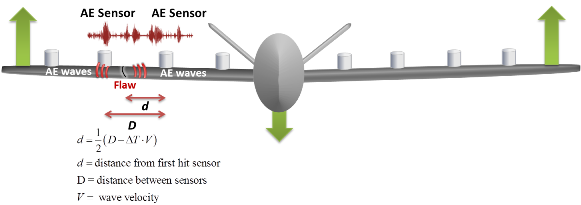
Wing load test is a standard procedure during new airplane design and in special cases applied in-service. Composite and metal wings are loaded to above operational loads or to an ultimate load to learn load bearing capabilities of wings and identify design weaknesses. Several methods were developed during recent decades to monitor wing performance, however there is only one method which is capable to provide real-time information about initiation and growth of discontinuities in metal or composite wing structure – acoustic emission technology.
Specially developed by ID, Wing DAE solution for wing stress test allows to:
- Identify stress level under which wing structure begin to develop flaws. It helps to define range of safe operational stresses.
- Identify micro- and macro- cracks in metal structure and in the entire wing cross-section.
- Identify and differentiate between matrix cracking, delamination growth and fiber breakage in composite wing structure including it spars, ribs, skin. etc.
- Identify load modes that most significantly contribute to flaw origination and development.
- Predict failure at 40% to 70% of failure load.
When Wing DAE is applied in-service it is possible to monitor wing condition periodically and to answer on the following questions:
- Are there any new flaws in the structure?
- Have any exiting flaws developed?
- Are there any fracture critical flaws that may cause wing failure in flight conditions.
Wing DAE was developed to provide comprehensive and accurate examination of the wing integrity. A special attention was made on development of the most sensitive, robust approach, apparatus and algorithms that allows high detectability, location and assessment of flaws while minimizing false positive findings by special pattern recognition algorithms used for filtering out high frequency noises due to friction and machinery operation.
Unlike other non-destructive methods acoustic emission detection is not limited to surface or near surface of the wing structure nor have any limitation in regard of wing’s material. A question about flaw criticality that often rise when flaw indications are detected can be in most of the cases effectively answered by diagnostic acoustic emission technology.
Leave a Reply